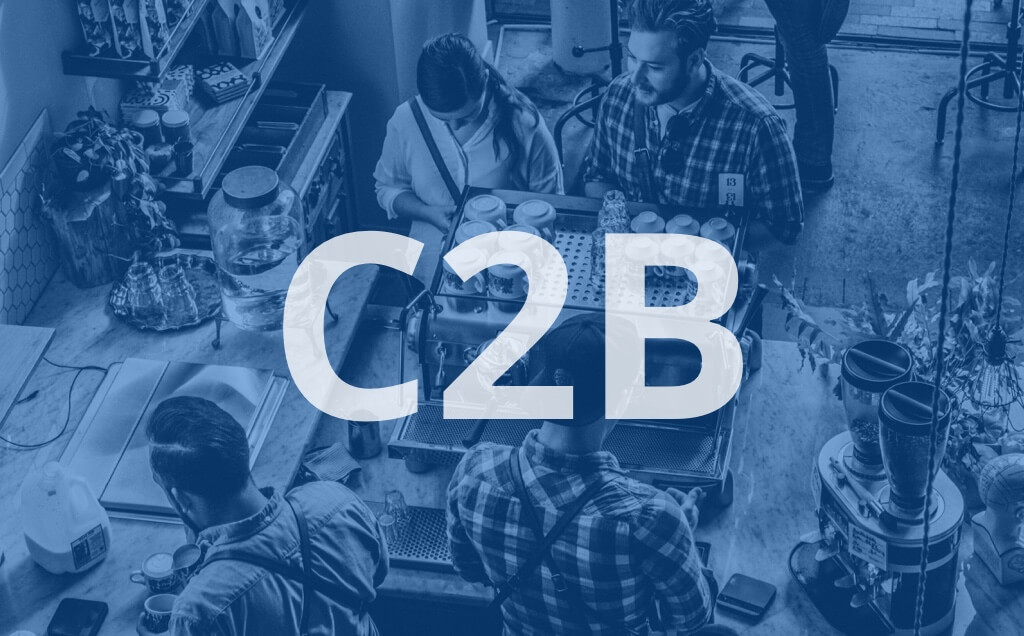Business Definition of “C2B”
C2B stands for Consumer-to-Business, and is used to describe a business model where consumers deliver value to a business rather than vice-versa as in a B2C (Business-to-Consumer) model. Examples of C2B models include referral programs, paid testimonials, or data sharing.
B2B and B2C are likely in your marketing vocabulary, but the consumer-to-business or “C2B” model is a relatively new approach gaining momentum.
The C2B strategy gets consumers to provide services or products that appeal to businesses, rather than companies providing something to the consumer as we’re used to seeing with B2C and other marketing models.
Let’s dive into the C2B business definition, why you need to adopt it, and see some practical examples to help you get started with the C2B marketing strategy.
C2B Business Definition: What is the Consumer to Business Model?
In broad terms, the definition of C2B business is a model where a customer or end-user makes content, products, or services that a company uses to complete a business process.

With the consumer-to-business approach in practice, companies can find potential business prospects within their consumer portfolios. It’s somewhat like cross-selling, but the inversion allows consumers more voice (and a piece of the business process).
C2B evolved more recently because popular consumer-generated media and content across consumer segments-social networks, websites, blogs, podcasts, and videos-have changed business processes. In today’s world, consumers can post their thoughts on brands whenever they want; companies must adapt to new ways of marketing themselves.
How Does C2B Marketing Work?
The consumer trend of being more involved in the products and services they use is changing expectations. Many companies are hesitant to adopt this model because it’s difficult to know where and how to start.
Sites like Facebook, Twitter, Instagram offer a way for businesses to communicate with their consumers while also creating new customer profiles that advertisers can target based on specific demographics. The companies can then provide their customers tailored information about products/services that would be most appealing to them or, in true C2B fashion, have some select customers create their content to target like-minded consumers with similar interests.
The old-fashioned way of marketing was a one-sided conversation where the company would spend advertising dollars for their products or services without really knowing whom they were going to target their message. Spending these ad dollars ended up being highly ineffective - no one wants irrelevant ads coming at them 24/7. With companies now understanding the impact of word-of-mouth marketing shifting from “talking head” advertising towards consumer blogs, social accounts, and other online entities, the C2B model is not only becoming more popular, it’s becoming a necessary strategy.
We are in an era where authenticity is king and mass persuasion isn’t working. Businesses are finding it increasingly difficult to reach their target audience traditionally.
The consumer-to-business strategy is a refreshing take on how consumers want interactions with business these days: the consumers demand from you what they’re willing and able to pay for themselves instead of being persuaded or tricked into buying something that doesn’t suit them well.
The process begins when businesses identify people who match their target customer profile and then create cohort groups for targeted communication purposes. Instead of running ads across all channels like you’re used to, companies now must focus on one-to-one interactions with these specific customers.
You can’t fake what’s authentic or try to persuade someone without any degree of mutual understanding; there must be some emotional connection established beforehand through personal conversations before anything else happens.
The C2B relationship also allows consumers to occasionally do some work, with companies supplying tools and other resources. In fact, for many industries or categories like software development, this model is not just a trend but could potentially be considered ubiquitous.
C2B Examples You Can Leverage Immediately
Increase Brand Awareness
One way that C2B relationships are helpful is when businesses have consumers help create brand awareness. Traditionally, press coverage highlighting new product launches and critical developments was critical for digital companies.
Writing a professional-quality press release can expand your reach by providing more ways to get published in media outlets. Heck, you can even use C2B to have a freelancer craft your press release. But even better than going through traditional channels could be getting your top consumers or so-called brand ambassadors creating a little digital buzz.
It’s becoming increasingly clear how powerful people’s voices can become as they share their opinions on social media platforms like Facebook or Twitter. According to the 2021 PEW Social Media Use report, 81% of U.S. adults use Youtube, and 69% favor Facebook, respectively, making them the most widely used online platforms for Americans today. Imagine tapping into a few key customers and their network of followers. The results of their post could grow your business exponentially overnight.
Give your customers opportunities like asking for assistance in social media exposure, invite them as VIPs to product launches or niche forums where they are likely to have to become evangelists with a small reward. The most common form of C2B is affiliate marketing or sponsored content by influencers or brand ambassadors.
Request More Reviews
Online reviews live forever, and these digital consumer snapshots can make or break a business instantly. Think about the last time you were going to make a purchase. Do you rely on reviews to make decisions as a consumer?
More businesses need this customer input right now because online ratings have become one of the top deciding factors for whether new buyers will choose any given brand over another. It’s not just enough anymore that you offer goods or excellent service at reasonable prices - these days every company needs positive words from the public to sell.
One of the defining aspects of C2B businesses is the ability to capitalize on simple, customer-based feedback, and what better way to do this than asking for reviews?
Rewards for reviews don’t have to be monetary either. Brands can offer a whole slew of perks to customers who raise their reputations like discount codes, sweepstakes entries, extra capabilities inside your SaaS platform, or early access to new features.
More C2B Examples
Freelancers, Contractors, and Gig Workers
In recent years, the freelance work industry has exploded. Freelancers can provide everything from a press release to an entire logo for clients who need assistance in these areas but are unable or unwilling to hire full-time employees.
And there’s no shortage of freelancers, either. According to the Freelancing in America report commissioned by Upwork and Freelancers Union, 57 million Americans - that’s 35% of the U.S. workforce - participated in freelancing projects in 2019, and the numbers continue to grow.
Companies such as Upwork, Fiverr, and Scripted have been made possible by freelancer’s ability to connect with potential employers and companies’ needs for fast and thorough projects. Upwork and Fiverr wouldn’t exist without the customer’s supply (freelancers’ services) and businesses’ demand.
Royalty-Free and Licensed Photography
Piggybacking off marketing contractors and freelance copywriters are photographers. Businesses like Shutterstock and Unsplash depend upon user-generated photography to keep their profit margins high.
Freelance and professional photographers - business owners in their own right - choose to offer their stylized images for a fee, not only helping the image hosting sites thrive but benefiting other businesses in need of stock imagery as well.
In this way, both the royalty-free image websites and the businesses looking to utilize the photography in their blogs, social media, or marketing campaigns, and the photographer who composed and captured the image benefit from the C2B business model.
Why Use C2B?
Businesses are looking for new ways to reach their target audience, but traditional marketing methods can be expensive and time-consuming.
Why should you bother adopting this model? It’s simple: You can save money on labor costs by using customer-generated content instead of hiring an expensive team as your competition does.
Growing businesses can use this type of marketing for many different purposes, such as generating leads from like-minded customers, increasing customer retention and satisfaction rates, and promoting new product launches with less overhead.
It also allows customers to make an informed decision about purchasing goods from your company without having any pressure from salespeople. The customer helps drive the business, the business listens to the customer, and everybody wins.
 Patrick Ward
Patrick Ward 

 BPO (Business Process Outsourcing): Meaning and Definition
BPO (Business Process Outsourcing): Meaning and Definition